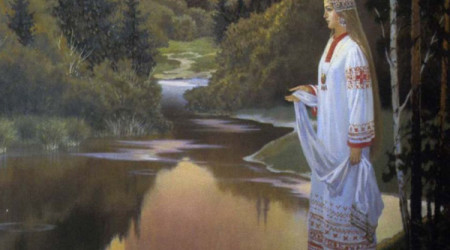
Strokes to the Picture of the Russian People
January 17, 2015
*East Slavs and Their Role in Europe and in the World*
East Slavs are classified into three closely related nations: the Russian, the Ukrainian and the Belorussians. Their common historical root ascends to the Old Russian ethnic group created in course of the unitary state formation – the Rus. This ethnic group in its turn emerged from many Slavic tribes inhabited the immense territory throughout the East European Plain and the Dnieper river basin – from the Baltic Sea in the North up to the Black Sea in the South.
The Old Russian state was established in 862 AD when the Scandinavian Varangians settled in Novgorod, the first Russian capital. Then the capital moved to Kiev; the power grew stronger, the state centralized and in 988 AD embraced Christianity despite the resistance of the Varangian Pagan headship. This event is deemed the key milestone on the way towards the Rus State formation, development of its culture and national identity. It was Knyaz (Prince) Yaroslav the Wise, the son of Knyaz (Prince) Vladimir, the Christianizer of Rus, who fairly considered himself one of the most prominent European monarchs, and his daughter Anna has become one of the greatest French Queens.
As it is all Medieval states came through periods of feudal disunity. The Rus was not an exception as well. Being weakened, divided into pieces of principalities it became the plunder for a powerful enemy as Mongol and Turkish tribes. Despite the desperate resistance the Russian Princes appeared to be not wise enough to unite their principalities and as a result became vassals of the Golden Horde.
Along with this it was the fact of a valorous rebellion against the barbarians for the sake of freedom and faith that became the factor of ebbing Tartars push on the Christian Europe. This push broke down on the very territory of the nearest Rus’ neighbors – the Poles. It is a fair assumption to say that it was just the time when the Rus became the shield for Europe against the Asian expansion. Thus, it was the Medieval Period when the Rus played by no means an unimportant role in a global world order.
All in all, the very place to take in the history by the Eastern Slavs is as a rule associated with the peculiarities of their geographical settlement at the turn of two civilizations, in particular the East and the West. The geographical aspect was by all means one of the most important but not the only one to determine the East Slavs’ role in Europe and in the world. The peculiarities of culture, national character and Orthodoxy sure enough significantly defined their role.
So-called “contiguous” nations that is the nations across two different, or rather opposite by nature civilizations have always had much in common, which made them kin. Thus, in historical terms our nearby neighbors and fraternal Slavs (the Poles, the Czecks, the Slovaks) are hardly related to the Russian along with the faraway Spaniards. It goes without saying that language similarity is not taken into account hereby. Yet the Spaniards like the East Slavs have also been across the Christian and Islamic civilizations, come through a long-lasting period of Arab enslavement and served a shield for Europe against the East Asian expansion as well.
Both the Iberian Peninsula nations and the nations of the East Europe were significantly affected by the past conquerors not only as for their way of living and culture but also the formation of national character, meanwhile preserving their religion, national identity, language and the ultimate cultural background.
*National Character of the East Slavs*
The term “national character” is rather relative. It has something in common with the notion “national identity”. As the mystery of any identity is perceived not by intellectual but only a spiritual way, there is always something impossible to perceive thoroughly. It was Tyutchev who wrote “Russia cannot be understood with the mind alone”. And Berdyaev declared that there were the “Theological Virtues” of Faith, Hope and Charity that were necessary to perceive it.
He also wrote that the Slavs could both enchant and disappoint, make themselves both greatly loved and hated: “It is the Jewish people the Russian people can be compared with in terms of polarization and complexity of contradictions. And it is not for nothing that they are the peoples with strong messianic consciousness”. It is yet no more proof of the fact that two fundamentals that is Eastern and Western ones have always combined and fought in Russian, Ukrainian and Belorussian national character. This combination and this fight determine the contradiction of the Russian soul, which shall be referred to hereafter.
A famous Russian-American sociologist, political analyst and philosopher Pitirim Sorokin wrote that the Russian nation appeared to him neither the Russian Empire, nor the USSR: “The Russian nation comprises three main branches of the Russian people – the Great Russians, the Ukrainians and the Belorussians, as well as “russified” or assimilated ethnic groups”. **
The history of the Russian nation covers the period of more than thousand years. Let’s dwell on five periods of this history to see the way of national character of the Russian nation formation. One of the most efficient periods was the first one called the Novgorod-Kievan period. Kiev and in a greater degree Novgorod were not closed off from the world: Kievan politicians and Novgorod merchants fairly considered themselves Europeans and the Rus – one of the greatest world powers.
Comments